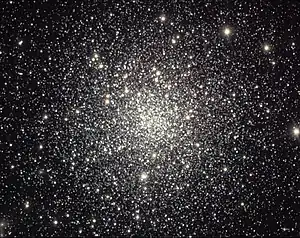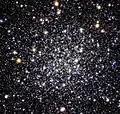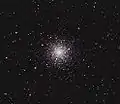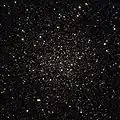Messier 12
Messier 12 or M 12 (also designated NGC 6218) is a globular cluster in the constellation of Ophiuchus. It was discovered by the French astronomer Charles Messier on May 30, 1764, who described it as a "nebula without stars".[7] In dark conditions this cluster can be faintly seen with a pair of binoculars. Resolving the stellar components requires a telescope with an aperture of 8 in (20 cm) or greater.[8] In a 10 in (25 cm) scope, the granular core shows a diameter of 3′ (arcminutes) surrounded by a 10′ halo of stars.[7]
| Messier 12 | |
|---|---|
 Globular cluster Messier 12 in Ophiuchus Credit: Michael Gariepy/Adam Block/NOAO/AURA/NSF | |
| Observation data (J2000 epoch) | |
| Class | IX[1] |
| Constellation | Ophiuchus |
| Right ascension | 16h 47m 14.18s[2] |
| Declination | –01° 56′ 54.7″[2] |
| Distance | 15.7 kly (4.8 kpc)[3] |
| Apparent magnitude (V) | +7.68[4] |
| Apparent dimensions (V) | 16′.0 |
| Physical characteristics | |
| Mass | 8.7×104[5] M☉ |
| Radius | 37.2 ly[NB 1] |
| Metallicity | = –1.14[6] dex |
| Estimated age | 12.67 Gyr[6] |
| Other designations | NGC 6218[4] |
Roughly 3°[8] northwest from the cluster M10 and 5.6° east southeast from star Lambda Ophiuchi, M12 is about 15,700 light-years (4,800 parsecs)[3] from Earth and has a spatial diameter of about 75 light-years. The brightest stars of M12 are of 12th magnitude. With a Shapley-Sawyer rating of IX,[1] it is rather loosely packed for a globular and was once thought to be a tightly concentrated open cluster. Thirteen variable stars have been recorded in this cluster. M12 is approaching us at a velocity of 16 km/s.[9]
A study published in 2006 concluded that this cluster has an unusually low number of low-mass stars. The authors surmise that they were stripped from the cluster by passage through the relatively matter-rich plane of the Milky Way.[10]
Notes
- distance × sin( diameter_angle / 2 ) = 37.2 ly radius
References
- Shapley, Harlow; Sawyer, Helen B. (August 1927), "A Classification of Globular Clusters", Harvard College Observatory Bulletin, 849 (849): 11–14, Bibcode:1927BHarO.849...11S.
- Goldsbury, Ryan; et al. (December 2010), "The ACS Survey of Galactic Globular Clusters. X. New Determinations of Centers for 65 Clusters", The Astronomical Journal, 140 (6): 1830–1837, arXiv:1008.2755, Bibcode:2010AJ....140.1830G, doi:10.1088/0004-6256/140/6/1830.
- Boyles, J.; et al. (November 2011), "Young Radio Pulsars in Galactic Globular Clusters", The Astrophysical Journal, 742 (1): 51, arXiv:1108.4402, Bibcode:2011ApJ...742...51B, doi:10.1088/0004-637X/742/1/51.
- "M 12". SIMBAD. Centre de données astronomiques de Strasbourg. Retrieved 2006-11-15.
- Marks, Michael; Kroupa, Pavel (August 2010), "Initial conditions for globular clusters and assembly of the old globular cluster population of the Milky Way", Monthly Notices of the Royal Astronomical Society, 406 (3): 2000–2012, arXiv:1004.2255, Bibcode:2010MNRAS.406.2000M, doi:10.1111/j.1365-2966.2010.16813.x. Mass is from MPD on Table 1.
- Forbes, Duncan A.; Bridges, Terry (May 2010), "Accreted versus in situ Milky Way globular clusters", Monthly Notices of the Royal Astronomical Society, 404 (3): 1203–1214, arXiv:1001.4289, Bibcode:2010MNRAS.404.1203F, doi:10.1111/j.1365-2966.2010.16373.x.
- Thompson, Robert Bruce; Thompson, Barbara Fritchman (2007), Illustrated guide to astronomical wonders, DIY science O'Reilly Series, O'Reilly Media, Inc., p. 137, ISBN 978-0596526856.
- Monks, Neale (2010), Go-To Telescopes Under Suburban Skies, Patrick Moore's Practical Astronomy Series, Springer, p. 118, ISBN 978-1441968500.
- "Messier 12: Gumball Globular | Messier Objects". www.messier-objects.com. Retrieved 2015-08-17.
- How to Steal a Million Stars?, ESO, February 7, 2006, archived from the original on February 8, 2007.
External links
| Wikimedia Commons has media related to Messier 12. |






